Often considered a minor pathogen, angular leaf spot caused by the bacterium, Xanthomonas fragariae, can cause serious leaf and calyx infections ruining the marketability of fruit if left uncontrolled. [Read more…]
Understanding and controlling angular leaf spot in strawberries
Often considered a minor pathogen, angular leaf spot caused by the bacterium, Xanthomonas fragariae, can cause serious leaf and calyx infections ruining the marketability of fruit if left uncontrolled. Like all bacterium, the pathogen will infect leaves and the calyx through natural openings or wounds. Primary infections of new growth in the spring originate from systemically infected overwintered plants and dead leaves in which the bacterium survives the winter; or from infested transplants. The pathogen is very resistant to desiccation and can survive in old, dried leaves or infected plant debris buried in the soil. The pathogen will not survive free in the soil so it originates primarily from infected leaf debris and infected crowns.
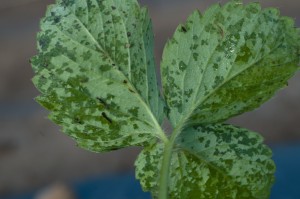
Fig. 1. Water-soaked lesions caused by angular leaf spot on infect strawberry leaf. Photo by P. Nitzsche
Infections can often start in production operations and come in on infected bare root transplants or cuttings. Symptoms on leaves include initial small, irregular water-soaked lesions (Fig. 1). Young, actively growing leaves are most susceptible, especially on vigorously growing plants. Disease development is favored by moderate to low daytime temperatures, low night time temperatures – near or below freezing, and high relative humidity. Long periods of precipitation, overhead irrigation used to establish plantings or protect plantings from freezing, and heavy dews favor disease development.
[Read more…]
Angular Leaf Spot in Strawberries
Often considered a minor pathogen, angular leaf spot caused by the bacterium, Xanthomonas fragariae, can cause serious leaf and calyx infections ruining the marketability of fruit if left uncontrolled. Like all bacterium, the pathogen will infect leaves and the calyx through natural openings or wounds.

Fig. 1. Water-soaked lesions caused by angular leaf spot on infect strawberry leaf. Photo by P. Nitzsche
[Read more…]
Recognizing Angular Leaf Spot in Cucurbits
Angular leaf spot is common in New Jersey and the region. It often shows up during cool, wet weather and isolated rain.
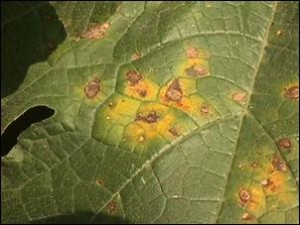
Symptoms of angular leaf spot in cucurbit.
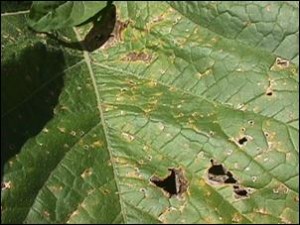
Angular leaf spot of pumpkin. Note leaf ‘shot holes’.
Angular leaf spot will first appear as, small water-soaked lesions which will expand until they reach a larger leaf vein resulting in the angular looking symptoms on leaves. Under heavy disease pressure, the bacteria will infect fruit causing small, water-soaked circular spots. In many cases once weather conditions become dry again, infected tissue in leaves will die and fall out leaving the characteristic ‘shot hole’ symptoms. Control of angular leaf spot begins with the application of labeled rates of fixed copper plus mancozeb to help suppress the spread of the disease until hot, dry weather returns.
Angular Leaf Spot in Fall Transplanted-Strawberries
There have been a few reports of angular leaf spot (ALS) caused by the bacterium, Xanthomonas fragariae, in strawberry in the northern part of New Jersey. Often considered a minor pathogen, ALS can cause serious leaf and calyx infections ruining the marketability of fruit if left uncontrolled. Like all bacterium, the pathogen will infect leaves and the calyx through natural openings or wounds.

Fig. 1. Water-soaked lesions caused by angular leaf spot on infect strawberry leaf. Photo by P. Nitzsche
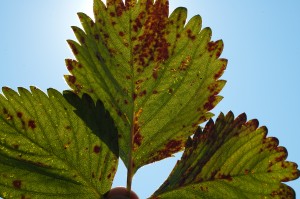
Fig. 2. Reddish-brown lesions on infected strawberry leaf caused by angular leaf spot. Note the translucent spots when held up to light. Photo by P. Nitzsche
Importantly, in severe outbreaks in the spring, the bacterium can spread to fruit causing the calyx to turn brown and dry out ruining the marketability of infected fruit (Figs. 3 & 4).

Fig. 3. Angular leaf spot infections on calyx of infected strawberry fruit. Photo by P. Nitzsche
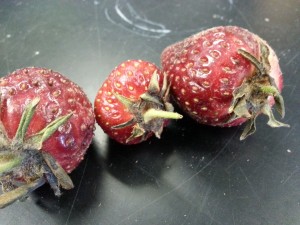
Fig 4. Strawberry fruit infected with Angular leaf spot. Note the brown, dried up calyx.
The pathogen is easily spread via overhead irrigation and during rain and can be moved around the field during harvest. The bacterium may overwinter on infected plant debris buried in the soil for up to one year. The best method for controlling angular leaf spot is to buy clean transplant material. Conventional or organic copper-based products can help suppress the development of ALS, and should be applied at a low rate to avoid phytotoxicity in leaves. Weekly, preventative applications of 0.3 lb fixed copper have been shown to be effective in reducing ALS if applied early enough when disease pressure was still low.
Vegetable Disease Update – 5/17/13
This past week there were a few reported cases of bacteria causing problems in tomato transplants, along with an isolated case of pith necrosis from the field as well as bacteria causing issues in strawberry. There have been no reports of late blight or cucurbit downy mildew in the region to date. [Read more…]
